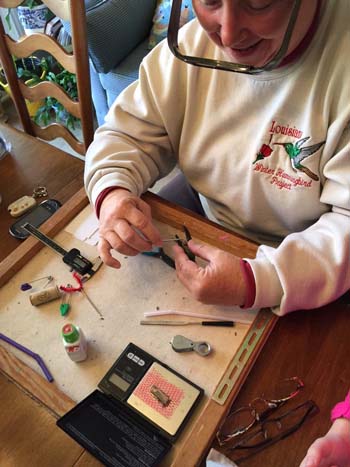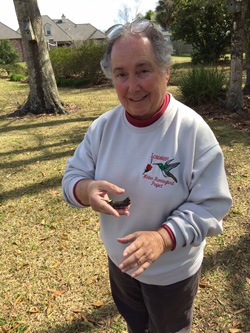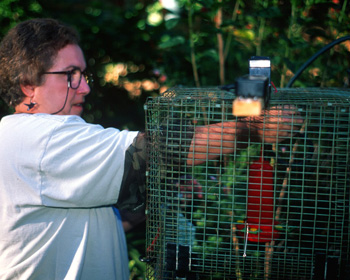Sage Experts: Nancy L. Newfield's Hummingbird Journey

This is the first article in a 3-part series about Louisiana hummingbird researcher and wildlife gardener Nancy L. Newfield.
As if signaling a race to begin, Mary Hosier of the educational website Hummingbird Journey North (March 4, 2016 Migration News) cheered, "Aaaand… we're off!"
Hosier said the first reports of hummingbird sightings signaling the 2016 northward migration season had come in from Florida, Louisiana, Mississippi and Texas. The first person Hosier quoted in her report was hummingbird master bander and Salvia enthusiast Nancy Newfield of southern Louisiana.
Hosier noted Newfield's advice about how to tell the difference at this time of year between a male Ruby-throated Hummingbird (Archilochus colubris) that overwintered in the Southeast and one that is migrating from Mexico and winter grounds farther south.
As a rule, males migrate earlier than females. According to Newfield, migrant hummingbirds have more vibrant plumage than overwintering residents, which are still molting at this time of year.
Newfield told the FBTS Everything Salvias Blog that she sees Ruby-throated Hummingbirds all year, and some "have come from elsewhere to spend the winter season." She has hosted a young female at her home since February 1. On March 21, she saw her first male migrant of the season.

hummingbird in 2014.
Winter dwellers -- both Ruby-throateds and other species -- don't nest in Louisiana. When breeding season arrives, the winterers depart for other locales as locally breeding Ruby-throateds arrive to begin nesting. However, ornithologists wouldn't be so certain of this if it weren't for Newfield's research.
Self-Taught Citizen Scientist
Bird Watching, Audubon and The Wall Street Journal have profiled Newfield along with Smithsonian, which in 2012 called her "a celebrity in the small world of hummingbird banders."
Yet Newfield's prominence extends beyond banding and into the realm of wildlife gardeners who want to attract hummingbirds to their yards. Later in this article, we share a sidebar (In Nancy Newfield's Garden) with information about her recommendations for the best hummingbird flowers for the Southeast. Many work well in other regions.
Newfield was passionate about birding before she began studying Trochilidae -- a family so mesmerizing that they inspired the 1971 soft rock hit Hummingbird by Seals and Crofts (see the video below).
Southeastern hummingbird bander and wildlife gardener Nancy Newfield says, "The list of Salvia species, cultivars and hybrids that I've experimented with, grown, or tried to grow, is extensive." She estimates that 100 species have made their way into her garden.
"Because I am especially interested in attracting wintering hummers that may stay for four or five months, I am drawn to those that bloom in late summer into fall and beyond."
This practice aids hummingbirds migrating in autumn and late winter/early spring as well as those that overwinter in Louisiana.
Newfield's favorites include:
- Tropical Sage (Salvia coccinea)
- Pineapple Sage (Salvia elegans)
- Forsythia Sage (Salvia madrensis)
- Lavender Lace Autumn Purple Sage (Salvia purpurea 'Lavender Lace') and
- Giant Brazilian Sage (Salvia subrotunda).
However, Newfield says she has "quite a few" cultivars and hybrids of Anise-scented Sage (S. guaranitica), Mexican Bush Sage (S. leucantha) and Mountain Sage (S. microphylla), which bloom for much of the summer and into fall.
Cute Cupheas & Other Salvia CompanionsOther hummingbird favorites in her gardens include Cupheas, which are commonly referred to as having either a cigar or mouse-ear/bat-ear appearance due to the lack or configuration of petals. These include:
- Mexican Loosestrife (Cuphea aff aequipetala)
- Orange Cigar Plant (Cuphea schumannii) and
- David Verity Cigar Plant (Cuphea x 'David Verity').
Newfield highly recommends Shrimp Plant (Justicia brandegeeana) as a hummingbird attractor. She adds that she has "numerous cultivars," all of which are cold hardy to 22 degrees F. To make it easier to provide a constant and varying source of nectar for hummingbirds, she selects easy-care plants with long bloom times. In addition to Salvias and Cupheas, she cites:
- Fire Spike (Odontonema strictum)
- Honeysuckle (Lonicera sempervirens)
- Crimson Bottlebrush (Callistemon citrinus)
- Weeping Bottlebrush (Callistemon viminalis) and
- Turk's Cap (Malvaviscus spp.).
Newfield offers some simple advice for new hummingbird gardeners throughout the nation -- start small. She says to "get a few plants for immediate pleasure and attractiveness, then find additional plants that will become the heart and soul of the garden."
Of course, we wouldn't mind you going overboard in ordering (you keep us in business!) when perusing the hummingbird plants category of the FBTS online plant nursery catalog. However, starting a wildlife garden with a few well-selected plants is a wise plan.
Which hummingbird plants should you select for your local U.S. Department of Agriculture Cold Hardiness Zone and other growing conditions? You can answer many questions with our Salvia Finder and menu of hummingbird plants. Or you can contact us for ideas; wildlife garden design is one of our passions, and we're always glad to help you.
In 1973, Newfield hung her first nectar feeder to get a closer look at hummingbirds. A few years later, with gardening knowledge gathered from Robert Raether -- a fellow member of the Louisiana Ornithological Society -- Newfield discovered she could attract more "customers" with nectar-producing plants.

hummingbird favorites in Newfield's yard.
Time was in short supply for attending college in the early 1970s, because Newfield was a stay-at-home mother raising young children. So she followed in the footsteps of other self-made naturalists who didn't have degrees in their fields of research.
Famous and obscure examples of these citizen scientists abound, including conservationist John Muir, ornithological illustrator Genevieve Jones (called the "other Audubon") and southwestern plant hunter Josiah Gregg. Similar to Newfield, all were driven by passion to understand, research and protect some aspect of the natural world.
The closest master hummingbird bander lived 600 miles away from Newfield when she began studying banding to earn her permit. "I more or less taught myself, because there were no training programs as there are now," Newfield told Everything Salvias.
For guidance, Newfield sought mentoring from zoologists at Louisiana State University. She accessed the knowledge of Dr. Robert Newman -- collections manager at the university's zoology museum -- and Dr. John P. O'Neill and Dr. James Van Remsen, who taught her skills such as taking hummingbird measurements and how to record and maintain the data.
Newfield did her fieldwork close to home in her own gardens and the yards of friend's homes. Kitchen tables became her lab counters.
History of Hummingbird Banding
According to the U.S. Geological Survey, which administers the federal Bird Banding Lab, records of bird banding -- called "ringing" in Europe -- go back to the 16th century. However, it appears that hummingbird banding didn't begin until the 20th century due to the difficulty of creating and applying miniscule metal bands to hummingbird legs.
In a 2010 article published in the North American Bird Bander, Oklahoman Ellie Womack detailed the history of hummingbird banding in the U.S. Womack noted that the earliest known banding occurred in New Hampshire in 1923.
Sometime in the 1980s, the USGS Bird Banding Laboratory (BBL) formalized the practice and began requiring banders to show proof of training to apply for permits.
In 1979, Newfield gained a permit and began what was supposed to be a 5-year study of hummingbird winter activity in South Louisiana. Nearly 40 years later, the study remains underway. She bands almost all year long with the help of friends and graduate students in the biological sciences.
Newfield's home, which is just west of New Orleans, is known to birders as Casa Colibrí -- Spanish for "hummingbird house." In New Orleans' fashion, she refers to her banding team as the Casa Colibrí "krewe."
According to The Wall Street Journal profile of Newfield, in 2014 "about 250" people in the U.S. held permits to band hummingbirds. The small number is partly due to the rigorous training required by the BBL. Newfield was the twelfth person to be issued a permit.
Childhood Persistence & Love of Nature
Newfield developed an interest in nature and birds when very young even though no one else in her family was a birder.
"There was never a time when I was not attempting to grow various kinds of plants, " she told Everything Salvias. "I cannot remember a time when I was not interested in living things, all living things, but there was a clear focus on birds."
Newfield remembers her father as loving the outdoors, but "mostly for fishing." She says her dad's mother was an avid rose gardener. It was her paternal grandfather who was interested in wildlife. Although not a birder, he built birdhouses for martins and taught her "the differences between a thrush and a thrasher."
But Newfield says it was her brothers who taught her how to "prove my ideas," because they didn't accept what she asserted unless she was able to support it. This led to persistence in adulthood when facing naysayers who refused to believe that a number of hummingbird species were choosing to overwinter in Louisiana instead of heading south to the tropics.
In her Everything Salvias interview, Newfield recalled an example of this behavior. "Back in the 1970s, when I mentioned hosting Black-chinned Hummingbirds in winter, the question came up at a public meeting of birders, all more 'knowledgeable' than I was, and it was two guys that loudly declared that I did not know what I was talking about."
At that time, Louisiana birders thought the Ruby-throated Hummingbird was the dominant species overwintering in the state.
Louisiana Winter Hummingbird Project
Newfield describes herself as not having been particularly assertive as a young woman. But skeptics couldn't dissuade her from what she had seen.

from a banding trap.
In spring 1996, the Cornell Lab of Ornithology's Living Bird magazine published Newfield's essay Piecing Together the Hummingbird Puzzle. In it, she wrote about a Rufous Hummingbird (Selasphorus rufus) and seven young male Black-chinned Hummingbirds (Archilochus alexandri) spending the winter in her suburban yard in 1975. She noted the return of these species year after year.
Meticulous recordkeeping by Newfield and her Casa Colibrí Krewe eventually resulted in a winter tally (please see our sidebar Winter Hummingbirds in Louisiana) of 11 kinds of hummingbirds that had wintered in their state. From 1979 to 2015, the Krewe banded a total of 7,208 hummingbirds. More than half were Rufous Hummingbirds. Even Black-chinned winter residents outnumbered Ruby-throateds.
Furthermore, Newfield's study -- formally titled the Louisiana Winter Hummingbird Project -- showed that Ruby-throateds that nested in Louisiana in spring were not the ones overwintering there.
The study also has cast doubt on two long-held ideas about maintaining nectar feeders during winter. First, the study's data shows that, similar to people who return to favorite vacation areas, many banded hummingbirds are repeat winter residents in Louisiana. They survive Louisiana winters. So Newfield said it's unlikely that filling nectar feeders there in winter lures them to their death.
Second, it isn't just feeders that keep the hummingbirds coming back. Posting at the Hummingbird Forum website in May 2006, Newfield wrote, "I think the key to their survival is our human-altered landscapes. Feeders are a part of that, but the landscape plants provide sustenance where feeders are not maintained."
Winter Hummingbirds Banded in Louisiana
July 1979 - July 2015
The following species of hummingbirds have been recorded in Louisiana. The number shown are the numbers of each species which have been banded as part of the Louisiana Winter Hummingbird Project. (All except the Black-chinned x Lucifer are profiled on the Cornell Lab of Ornithology's eBird app.)
- Mexican (formerly "Green") Violetear — 0
- Green-breasted Mango — 0
- Rivoli's (formerly "Magnificent") Hummingbird — 0
- Blue-throated Hummingbird — 1
- Ruby-throated Hummingbird* — 951
- Black-chinned Hummingbird — 1,025
- Anna’s Hummingbird — 40
- Broad-tailed Hummingbird —118
- Rufous Hummingbird — 4,181
- Allen’s Hummingbird — 171
- Calliope Hummingbird — 275
- Broad-billed Hummingbird — 31
- Buff-bellied Hummingbird — 415
- Black-chinned x Lucifer Hummingbird — 1
Total 7,208
*Ruby-throated Hummingbirds also occur in Louisiana during the breeding season and spring and fall migration. Ruby-throated Hummingbirds banded during those seasons are not included in these numbers.
Source: Nancy Newfield and Casa Colibrí Krewe
Righteous Vigilance
Beware of seemingly unassertive little girls who are curious, ask lots of questions and have a pesky, scientific bent of mind. Armed with data obtained through pure doggedness, they may grow up to turn scientific "truths" upside down. That's what Newfield has done in the world of ornithology.
Hummingbird research is a relatively young pursuit. Newfield is as quick to point out what is unknown about these residents of the Western Hemisphere as she is to share, analyze and form theories from data she trusts.
When possible, she speaks up when out-of-date or false information about hummingbirds persists online and elsewhere. For example, ask her if she knows of an accurate state-by-state list of hummingbird species, and she won't waffle. There is no such list, Newfield says, because of the complications involved in coordinating and vetting information from bird records committees nationwide.
As Newfield told FBTS in a somewhat tongue-in-cheek manner, "Righteousness is a big job."
What to Expect Next
What's up next in this series? Part II talks about the year that Newfield discovered hummingbird gardening and includes an excerpt from Hummingbird Gardens, which Newfield coauthored with Barbara Nielsen. The excerpt provides an historical perspective on the family Trochilidae's obsession with the color red.
Part III takes you to Louisiana for hummingbird banding with Newfield's Casa Colibrí Krewe, complete with hummingbird cake (no birdies in it). It also offers a list of red flowers hummingbirds favor.
Questions? Please call or send us an email for more information about wildlife gardening. We'll help you get the good times rolling for hummingbirds in your garden.
 Salvia microphylla 'Honey Rose'
Salvia microphylla 'Honey Rose'  Salvia microphylla 'Wild Watermelon'
Salvia microphylla 'Wild Watermelon'  Salvia microphylla 'San Carlos Festival'
Salvia microphylla 'San Carlos Festival'  Salvia microphylla var. neurepia
Salvia microphylla var. neurepia  Salvia leucantha 'White Mischief'
Salvia leucantha 'White Mischief'  Salvia leucantha 'Danielle's Dream'
Salvia leucantha 'Danielle's Dream'  Salvia leucantha 'Greenwood'
Salvia leucantha 'Greenwood'  Salvia guaranitica 'Blue Ensign'
Salvia guaranitica 'Blue Ensign'  Salvia subrotunda
Salvia subrotunda  Salvia madrensis
Salvia madrensis  Salvia elegans 'Honey Melon'
Salvia elegans 'Honey Melon'  Salvia elegans
Salvia elegans  Salvia coccinea 'Brenthurst'
Salvia coccinea 'Brenthurst'  Salvia coccinea 'Forest Fire'
Salvia coccinea 'Forest Fire' 
1 Comments